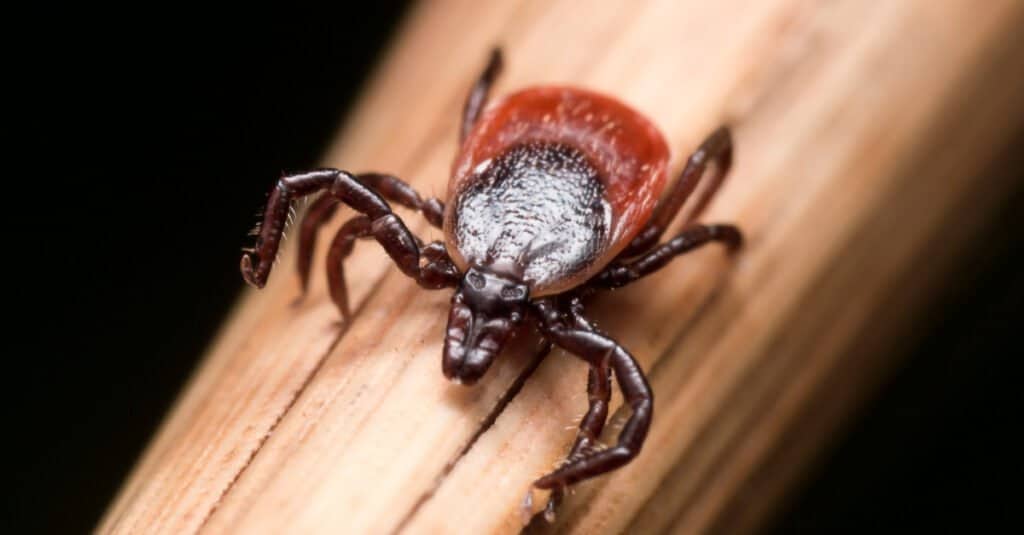In the spring and summer months, many people are eager to get out of the house and into nature. However, warmer weather brings more than humans to the great outdoors, it also kicks off the dreaded tick season. Apart from causing revulsion at the thought of finding a tick latched onto us or our beloved pets, ticks can be deadly. The biggest and most dangerous threat when it comes to ticks is Lyme disease. But which ticks carry Lyme disease?
The article below would give us more details.
Which Tick carries Lyme Disease?

The deer tick is the species that transmit Lyme disease.
©Steven Ellingson/Shutterstock.com
In the United States, the Lyme disease-causing bacteria Borrelia burgdorferi and Borrelia mayonii are carried by the black-legged, or deer tick species. But how can you tell if a tick is a deer tick, and how can you prevent picking up one? And what are the warning signs and symptoms of Lyme disease? Let us get into it!
How To Identify Deer Ticks

Deer ticks are reddish-brown with black legs and heads, which is why they are also referred to as black-legged ticks.
©KPixMining/Shutterstock.com
The first step to minimizing the risk of contracting Lyme disease is knowing how to properly identify a deer tick. Some other species, such as the dog tick, can appear like the deer tick. However, the dog tick has white markings on its underside where the deer tick is a solid color. Adult deer ticks are the size of a sesame seed, with a shield-like scutum behind the head, reddish-brown lower bodies, black legs, and heads. Larval or nymph deer ticks are even smaller, the size of a poppy seed or even the head of a pin. Adult ticks have the expected eight legs that mark an arachnid, while larval ticks only have six.
Warning Signs Of Lyme Disease
While Lyme disease is always transmitted by the deer tick, not all deer ticks carry Lyme disease. Due to their small size compared to other tick species, visual detection is unreliable. According to the CDC, it takes 24-36 hours after a deer tick attaches to the host to transmit Lyme disease. It is usually not the tick you see that spreads the bacteria; it is the tick you do not. Therefore, the best way to detect Lyme disease is by looking for the warning signs of infection.
The first sign of a tick bite or removal is a small red bump. This is common for all tick bites and should resolve itself within a few days. Early symptoms that indicate Lyme disease occur within one month of being infected, and later signs may appear up to months after. Knowing the signs and symptoms of Lyme disease is crucial for your safety. Prompt treatment for Lyme disease will not only clear up the symptoms but can also save your life.
- Early Signs And Symptoms: A red, warm-to-the-touch rash appearing from 3 to 30 days around the bite, expanding in a bulls-eye pattern up to twelve inches wide. The rash is often not itchy or painful. Additionally, fever, fatigue, body ache, neck stiffness, chills, headache, and neck stiffness may occur along with the rash.
- Later Signs And Symptoms: Severe joint pain and swelling, especially in the knees but may move from one joint to another. The initial rash may spread to other areas of the body as well.
- Possible Symptoms Months/Years After Infection: Neurological issues related to inflammation such as meningitis, temporary paralysis referred to as Bells Palsy, numbness or weakness in limbs, impaired muscle movement
- Less Common Signs And Symptoms: Heart problems, eye inflammation(hepatitis), severe chronic fatigue
Treatment For Lyme Disease
Lyme disease is commonly treated with antibiotics, the most common being doxycycline. However, the specific antibiotic depends on many factors such as known allergies and interactions with other medications. All medications taken for any illness should be prescribed by a healthcare professional. While antibiotics like doxycycline may be easy to obtain online, exact dosages depend on the individual. Improper dosage of antibiotics can cause resistance, ineffectiveness, illness, or even death in some cases.
When To See A Doctor

The most easily identified early symptom of Lyme disease is a progressive rash shaped in a bulls-eye pattern.
©Tomasz Klejdysz/Shutterstock.com
Only a small fraction of deer tick bites lead to Lyme disease. If the tick is attached for less than 36 hours, the risk is drastically minimized. However, the earlier you are diagnosed with Lyme disease, the more successful treatment will be. If you suspect you have been bitten by a deer tick, or exhibit any of the early signs or symptoms above, see your doctor as soon as possible. This is especially true for individuals that live in an area where deer ticks are common. Even if symptoms seem to disappear, seek medical attention, as Lyme disease can spread to other areas if left untreated. Also, Lyme disease is only one of the dangerous illnesses ticks transmit.
How To Prevent Picking Up A Tick Carrying Lyme Disease
Of course, the best tool to keep a tick from making us sick is by preventing them from attaching to us at all! Knowing where ticks live, how to repel them, and what to do if one is embedded in your dog, are all tools to protect you from all dangerous tick-related illnesses. In our article about how to get rid of ticks on your body and in your yard, we go into more detail. We also go over how to kill ticks on dogs, what ticks look like, and plenty of other ways to protect yourself and your pets in our other tick articles too!
Up Next:
- Zoonotic Diseases: 11 Animal-Borne Diseases You Should Know About
- How To Get Ticks Off Your Body And Out Of Your Yard
The photo featured at the top of this post is © KPixMining/Shutterstock.com
Thank you for reading! Have some feedback for us? Contact the AZ Animals editorial team.






